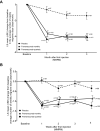Fremanezumab for Episodic Migraine Prevention in Japanese Patients: Subgroup Analysis from Two International Trials
- PMID: 37223438
- PMCID: PMC10202207
- DOI: 10.2147/JPR.S393896
Fremanezumab for Episodic Migraine Prevention in Japanese Patients: Subgroup Analysis from Two International Trials
Abstract
Purpose: The monoclonal antibody fremanezumab has been shown effective and well tolerated in numerous Phase 2 and Phase 3 trials. This subgroup analysis of the international HALO episodic migraine (EM; [NCT02629861]) trial and a similarly designed phase 2b/3 trial in Japanese and Korean patients (NCT03303092) sought to evaluate the efficacy and safety of fremanezumab in Japanese patients with EM.
Patients and methods: In both trials, eligible patients were randomly assigned at baseline to receive subcutaneous monthly fremanezumab, quarterly fremanezumab, or placebo in a 1:1:1 ratio. The primary endpoint was the mean change from baseline in the monthly (28-day) average number of migraine days during the 12-week period after the first dose of fremanezumab or placebo. Secondary endpoints assessed other aspects of efficacy, including disability and medication use.
Results: A total of 301 patients in the Japanese and Korean phase 2b/3 trial and 75 patients in the HALO EM trial were Japanese with baseline and treatment characteristics similar between treatment groups. According to ANCOVA analysis of the primary endpoint, both fremanezumab quarterly and monthly led to greater reductions in the monthly (28-day) average number of migraine days than placebo. This was supported by MMRM analysis of the primary endpoint over the initial 4 weeks, highlighting the rapid onset of action of fremanezumab. Results of secondary endpoint analysis supported the primary endpoint analyses. Fremanezumab was well tolerated with no new safety signals seen in this population of Japanese patients.
Conclusion: Fremanezumab appears to be an effective and well-tolerated preventive medication for Japanese patients with EM.
Keywords: Japanese; calcitonin gene-related peptide; episodic migraine; fremanezumab.
© 2023 Saigoh et al.
Conflict of interest statement
KS has received grants from Sumitomo Pharma Co., Ltd.; consulting fees from Takeda Pharmaceutical Co., Ltd., Otsuka Pharmaceutical Co., Ltd.; payment for lectures from AMGEN Inc., Daiichi Sankyo Company, Eisai Co., Ltd., Eli Lilly Japan, Otsuka Pharmaceutical Co., Ltd., Sanofi Japan, Sumitomo Pharma Co., Ltd., Takeda Pharmaceutical Co., Ltd.; committee member for Japanese Society of Headache, Japanese Society of Human Genetics. TT has received honoraria for lectures from Eisai Co., Ltd., Otsuka Pharmaceutical Co., Ltd., Amgen K.K., Eli Lilly and Company, Daiichi Sankyo; research funds under contract from Eisai Co., Ltd., Eli Lilly and Company, Amgen K.K., Allergan Japan K.K., Shionogi & Co., Ltd., Lundbeck Japan K.K. MN, YS, MI, YI, and NK are full-time employees of Otsuka Pharmaceutical Co., Ltd. XN and SB are full-time employees of Teva Branded Pharmaceutical Products. The authors report no other conflicts of interest in this work.
Figures


Similar articles
-
Fremanezumab for Chronic Migraine Prevention in Japanese Patients: Subgroup Analysis from Two International Trials.J Pain Res. 2023 Apr 20;16:1311-1319. doi: 10.2147/JPR.S393854. eCollection 2023. J Pain Res. 2023. PMID: 37101521 Free PMC article.
-
Effects of fremanezumab on migraine-associated symptoms and medication use in Japanese and Korean patients with episodic migraine: Exploratory endpoint analysis of a multicenter, randomized, double-blind, placebo-controlled trial.Headache. 2025 Mar;65(3):399-406. doi: 10.1111/head.14810. Epub 2024 Sep 2. Headache. 2025. PMID: 39221611 Free PMC article. Clinical Trial.
-
Efficacy and safety of fremanezumab for episodic migraine prevention: Multicenter, randomized, double-blind, placebo-controlled, parallel-group trial in Japanese and Korean patients.Headache. 2021 Jul;61(7):1102-1111. doi: 10.1111/head.14178. Epub 2021 Jul 29. Headache. 2021. PMID: 34323290 Free PMC article. Clinical Trial.
-
Fremanezumab: a disease-specific option for the preventive treatment of migraine, including difficult-to-treat migraine.Emerg Top Life Sci. 2020 Sep 8;4(2):179-190. doi: 10.1042/ETLS20200018. Emerg Top Life Sci. 2020. PMID: 32832978 Free PMC article. Review.
-
Monthly versus quarterly fremanezumab for the prevention of migraine: a systemic review and meta-analysis from randomized controlled trials.Naunyn Schmiedebergs Arch Pharmacol. 2021 Apr;394(4):819-828. doi: 10.1007/s00210-020-02009-7. Epub 2020 Nov 2. Naunyn Schmiedebergs Arch Pharmacol. 2021. PMID: 33136176
Cited by
-
Targeting Perineural Invasion in Pancreatic Cancer.Cancers (Basel). 2024 Dec 21;16(24):4260. doi: 10.3390/cancers16244260. Cancers (Basel). 2024. PMID: 39766161 Free PMC article. Review.
-
Real-world evidence of fremanezumab for treating migraine in Japan: a retrospective study.BMC Neurol. 2023 Nov 14;23(1):404. doi: 10.1186/s12883-023-03449-3. BMC Neurol. 2023. PMID: 37964188 Free PMC article.
-
Efficacy and continuability of 675 mg fremanezumab administration over 2 years.J Headache Pain. 2025 Mar 11;26(1):51. doi: 10.1186/s10194-025-01994-5. J Headache Pain. 2025. PMID: 40069630 Free PMC article.
References
-
- Lipton RB, Manack Adams A, Buse DC, Fanning KM, Reed ML. A comparison of the Chronic Migraine Epidemiology and Outcomes (CaMEO) study and American Migraine Prevalence and Prevention (AMPP) study: demographics and headache-related disability. Headache. 2016;56(8):1280–1289. doi:10.1111/head.12878 - DOI - PMC - PubMed
LinkOut - more resources
Full Text Sources

